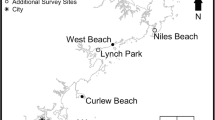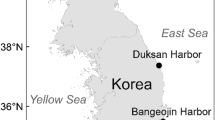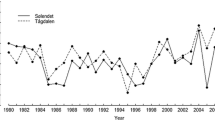Abstract
Sexual reproduction in Posidonia oceanica (L.) Delile is likely to be highly variable both in space and time. However, there has been little effort to identify at what spatial scale variability exists in the distribution and abundance of reproductive shoots or the magnitude of these variations. Such information is important for elucidating several aspects of the reproductive strategy of this species. Here, by using a reconstructing technique, I estimated the rate at which flowering events occurred over the last decades in three P. oceanica meadows along the coastline of the north-western Mediterranean (Italy). Then, variation in inflorescence frequency (i.e. the percentage of shoots that flowered in a particular year of the total number of shoots present in the sample in that year) was examined on a hierarchy of spatial scales, ranging from a few metres to meadows separated by tens of kilometres over a 3-year period. Separate analyses were also conducted to examine the patterns of spatial variability of several plant characteristics (i.e. shoot age and density of vegetative shoots) that may influence the timing of flowering. In total, ten reconstructed flowering events were recorded during the period 1983–1999. Despite the similar climatic conditions experienced in the three meadows surveyed, no inflorescence scars were found in one meadow. In the other two meadows, the flowering rate fluctuated considerably from year to year (0–26%), and simultaneous flowerings were detected only in 3 years (1993, 1994 and 1995). The pattern of spatial variability in the inflorescence frequency varied among years. An investigation of the flowering events recorded along the north-western Mediterranean coast reveals that in the studied period flowering also occurred across a broad range of meadows. Therefore, flowering could be a far more widespread phenomenon in this sector of the Mediterranean basin than previously thought. Analysis of variance showed significant variation in 1993 at the mean inflorescence frequency on very small scales (metres to tens of metres), whereas variation was not found at any of the scales investigated in 1994 and 1995. Overall, variation in the inflorescence frequency within individual meadows (65–93%) was at least an order of magnitude greater than that among separate meadows (0.5–19%). Patterns of spatial variation in the plant characteristics examined did not reflect those of flowering. It may be hypothesised that internal rhythms of populations, in conjunction with changes in environmental conditions, which are consistent over relatively large spatial (kilometres), are involved in the control of flowering induction. Environmental heterogeneity (in terms of nutrient availability) on a very local scale (metres to tens of metres) and intrinsic factors might affect the distribution of reproductive shoots within P. oceanica meadows.



Similar content being viewed by others
References
Acunto S, Piazzi L, Balestri E, Cinelli F (1996) Segnalazioni di fioriture di Posidonia oceanica (L.) Delile lungo le coste toscane. Biol Mediterr 3:437–438
Balestri E, Cinelli F (2003) Sexual reproductive success in Posidonia oceanica. Aquat Bot 75:21–32
Balestri E, Piazzi L, Acunto S, Cinelli F (1995) Segnalazioni di fioriture lungo le coste ed isole toscane. In: Cinelli F, Fresi E, Lorenzi C, Mucedola A (eds) La Posidonia oceanica. Riv Maritt 12[Suppl]:25–27
Balestri E, Piazzi L, Cinelli F (1998) Survival and growth of transplanted and natural seedlings of Posidonia oceanica in a damaged coastal area. J Exp Mar Biol Ecol 228:209–225
Balestri E, Cinelli F, Lardicci C (2003) Spatial variation in Posidonia oceanica structural, morphological and dynamic features in a northwestern Mediterranean coastal area: a multi-scale analysis. Mar Ecol Prog Ser 250:51–60
Bell G (1980) The costs of reproduction and their consequences. Am Nat 116:45–76
Buia MC, Mazzella L (1991) Reproductive phenology of the Mediterranean seagrasses Posidonia oceanica (L.) Delile, Cymodocea nodosa (Ucria) Aschers., and Zostera noltii Hornem. Aquat Bot 40:343–362
Bussetti S, Guidetti P (1996) Studio lepidocronologico delle fioriture della prateria di Posidonia oceanica (L.) Delile di Noli (Baia di Spotorno, Mar Ligure). In: Atti del VII Congresso nazionale della Società Italiana di Ecologia vol 17. Società Italiana di Ecologia, Napoli, pp 305–308
Campey ML, Kendrinck GA, Walker DI (2002) Interannual and small-scale spatial variability in sexual reproduction of the seagrass Posidonia coriacea and Heterozostera tasmanica, southwestern Australia. Aquat Bot 74:287–297
Caye G, Meinesz A (1984) Observation sur la floraison et la fructification de Posidonia oceanica dans la baie de Villefranche et en Corse du Sud. In: Boudouresque CF, Jeudy de Grissac A, Olivier J (eds) Proceedings of the international workshop on Posidonia oceanica beds, vol 1. G.I.S Posidonie, Marseille, pp 193–201
Cook RE (1983) Clonal plant populations. Am Sci 71:244–253
Durako MJ, Moffler MD (1987) Factors affecting the reproductive ecology of Thalassia testudinum (Hydrocharitaceae). Aquat Bot 27:79–95
Eriksson O (1997) Clonal life histories and the evolution of seed recruitment. In: de Kroon H, van Groenendael J (eds) The ecology and evolution of clonal growth in plants. SPB Academic, The Hague, pp 221–226
Gallegos ME, Merino M, Marbà N, Duarte CM (1992) Flowering of Thalassia testidinum Banks ex König in the Mexican Carribean: age-dependence and interannual variability. Aquat Bot 43:249–255
Giraud G (1977) Recensement des floraisons de Posidonia oceanica (Linné) Delile en Méditerranée. Rapp P-V Reun Comm Intl Explor Sci Mer Mediterr Monaco 24:126–130
Gobert S, Defawe O, Lepoint G, Demoulin V, Bouquegneau J-M (2001) Anthesis effects on Posidonia oceanica (L.) Delile phenology in the Bay of Calvi (Corsica, Mediterranean Sea). Hydrobiologia 455:121–125
Huber H, Lukács S, Watson MA (1999) Spatial structure of stoloniferous herbs: an interplay between structural blue-print, ontogeny and phenotypic plasticity. Plant Ecol 141:107–115
Inglis GI, Lincoln Smith MP (1998) Synchronous flowering of estuarine seagrass meadows. Aquat Bot 60:37–48
Molinier R, Picard J (1953) Etudes biologiques sur les herbiers de phanérogames marines à l’Ouest d’Alger. Bull Stn Aquacult Pêche Castiglione 4:7–34
Olesen B (1999) Reproduction in Danish eelgrass (Zostera marina L.) stands: size-dependence and biomass partitioning. Aquat Bot 65:209–219
Orth RJ, Luckenback M, Moore KA (1994) Seed dispersal in a marine macrophyte: implications for colonization and restoration. Ecology 75:1927–1939
Peirano A, Stoppelli N, Bianchi CN (2000) Use of underwater photography for in situ monitoring of fruit development of Posidonia oceanica (L.) Delile. Biol Mar Mediterr 7:107–110
Pergent G (1987) Recherches Lépidochronologiques chez Posidonia oceanica (Potamogetonacea). Fluctuations des paramètres anatomiques et morphologiques des écailles des rhizomes. Thèse Doctor océanol., Univ. Aix-Marseille II, Marseille
Pergent G, Pergent-Martini C (1990) Some applications of lepidochronological analysis in the seagrass Posidonia oceanica. Bot Mar 33:299–310
Pergent G, Ben Maiz N, Boudouresque CF, Meinesz A (1989) The flowering of Posidonia oceanica over the past fifty years: a lepidochronological study. In: Boudouresque CF, Meinesz A, Fresi E, Gravez V (eds) Proceedings of the international workshop on Posidonia oceanica beds, vol 2. G.I.S Posidonie, Marseille, pp 69–76
Piazzi L, Acunto S, Balestri E, Cinelli F (1996) Osservazioni preliminari sulla germinazione di semi e sviluppo in situ di piantine di Posidonia oceanica (l.) Delile. Inf Bot Ital 28:61–66
Piazzi L, Balestri E, Cinelli F (2000) Grazing of inflorescences of the seagrass Posidonia oceanica (L.) Delile. Bot Mar 43:581–584
Price EA, Marshall C (1999) Clonal plants and environmental heterogeneity. Plant Ecol 141:3–7
Sandmeier M, Caye G, Molenaar H (1999) Seed polymorphism and autogamy of the seagrass Posidonia oceanica from the western Mediterranean. Bot Mar 42:359–366
Semroud R (1993) Donnees sur des floraisons anciennes de Posidonia oceanica (Linnaeus) Delile dans la region d’Alger (Algerie). Posidonia Newsl 4:31–35
Sokal RR, Rohlf FJ (1995) Biometry, 3rd edn. Freeman, New York
Taylor OR, Inouye DW (1985) Synchrony and periodicity of flowering in Frasera speciosa, Gentianaceae. Ecology 66:521–527
Thélin I, Boudouresque CF (1985) Posidonia oceanica flowering and fruiting recent data from an international inquiry. Posidonia Newsl 1:5–14
Tyler G (2001) Relationships between climate and flowering of eight herbs in a Swedish deciduous forest. Ann Bot 87:623–630
Watson MA, May MJM, Newton PCD (1997) Developmental phenology and the timing of determination of shoot bud fates: ways in which the developmental program modulates fitness in clonal plants. In: de Kroon H, van Groenendael J (eds) The ecology and evolution of clonal plants. Backhuys, Leiden
Wijesinghe DK, Hutchings MJ (1997) The effects of spatial scale of environmental heterogeneity on the growth of a clonal plant: an experimental study with Glechoma hederacea. J Ecol 85:17–28
Williams SL, Orth RJ (1998) Genetics and structure of natural and transplanted eelgrass populations in the Chesapeake and Chincoteague Bays. Estuaries 21:118–128
Underwood AJ (1997) Experiments in ecology: their logical design and interpretation using analysis of variance. Cambridge University Press, Cambridge
Acknowledgements
I am very grateful to Solvay & Co. Plant of Rosignano Solvay (Leghorn, Italy) for providing the financial support for this study. I wish to thank C. Lardicci for his contributions to the study. I also thank F. Vallerini and S. Bertini for valuable assistance in the field and in the laboratory. The sampling complied with the current laws of Italy.
Author information
Authors and Affiliations
Corresponding author
Additional information
Communicated by R. Cattaneo-Vietti, Genova
Rights and permissions
About this article
Cite this article
Balestri, E. Flowering of the seagrass Posidonia oceanica in a north-western Mediterranean coastal area: temporal and spatial variations. Marine Biology 145, 61–68 (2004). https://doi.org/10.1007/s00227-004-1301-2
Received:
Accepted:
Published:
Issue Date:
DOI: https://doi.org/10.1007/s00227-004-1301-2




